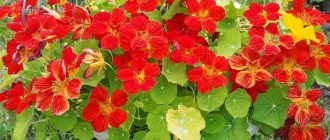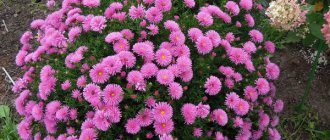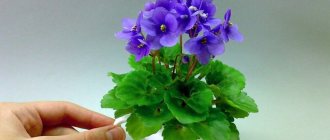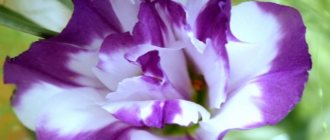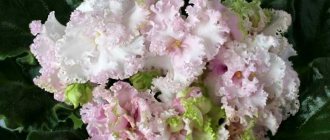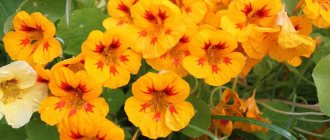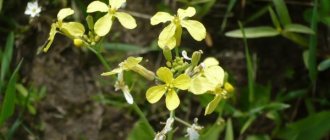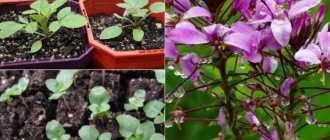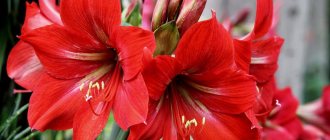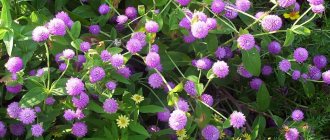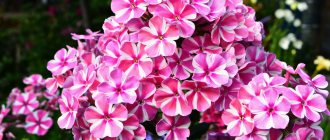07/15/2019 Irina Malinina 0 comments
Would you like to have a beautiful flower in your flowerbed, which in its properties is a garden nurse, cures many diseases, and is also suitable for food? Then pay attention to the nasturtium flower.
It prevents the spread of fungal infections, fusarium, root rot and nematodes. It is avoided by aphids, beetles, earth flies and other insects. Absolutely all above-ground parts of the plant are edible and contain a storehouse of vitamins. In many countries, dishes seasoned with nasturtium are considered an exquisite delicacy.
Would you like to try a savory salad or sandwich spread made from the flowers and leaves of this amazing plant? It's just a matter of small things - plant it in your garden plot, and then enjoy the beauty of the flowers, their taste and medicinal properties. And we will tell you how to do it correctly!
Nasturtium flower - botanical description
What is nasturtium? This is a herbaceous annual or perennial plant native to South America. Its natural range is from Peru to New Grenada. Nasturtium is very decorative; it was liked by the Spanish conquistadors who conquered Peru in 1580, and was brought to Europe as a trophy along with a considerable number of other South American plants.
Nasturtium was given a Latin name - Trophaeolum, which translated means “trophy”, “sign of victory”. The second name for nasturtium is Capuchin. So they began to call it because of the specific shape of the flower, which has a spur, so similar to the hood of the Capuchin monks.
Nasturtium is a perennial, but in cultivation it is grown as an annual. It is too thermophilic and cannot survive the frosts of central Russia.
What does nasturtium look like? The plant is often found in the form of vines 1-2 m in length, but can also grow as a bush, the height of which can start from thirty centimeters and end just above half a meter.
The stems are very juicy and well branched. The bright green leaves with slightly wavy edges have an unequal, rounded shape, 2.5 to 6 cm long, with a long petiole in the center. The leaves grow alternately.
The flowers are very bright, solitary, and have a pleasant aroma. Each flower usually has five petals, but sometimes their number can be greater - decorative varieties can be double or semi-double. The funnel-shaped tube “stores” nectar, which insects feed on and at the same time pollinate flowers. Nasturtium five-leaf is pollinated by exotic hummingbirds.
Each flower has an original spur, thanks to which the plant received its second name Capuchin. The color palette is warm. All shades of yellow, red, orange, cream. Many flowers on the petals have variegated contrasting spots, strokes, lines, which only increases the decorativeness and variety of colors.
Flowering begins in June and continues throughout the growing season, until the first frost.
The fruits are prefabricated achenes, consisting of three parts - kidney-shaped lobes of a round shape with a wrinkled surface. The seeds are also rounded and kidney-shaped. Their ripening period is August-September.
Brief characteristics of the plant
Nasturtiums are easy to grow. In its natural habitat, where the climate is warm, it is a perennial. Our nasturtiums are grown as annuals. The homeland of this plant is South America and Mexico, where it grows in the mountains. This flower was introduced to Europe in 1576.
| Height | The plant grows to a height of about 30 cm and develops branched, climbing stems that can reach a height of up to 3 m. |
| Flowers | Five-petalled flowers in warm shades of yellow, orange, red, brown and purple. The flowers are 4-5 cm in size. The calyx of the flower is decorated with a spur up to 3 cm long. |
| Flowering period | From June until frost. Blooms 8-10 weeks after sowing. |
| Leaves | Smooth, alternate, located on long petioles, edges entire. Light green in color with a bluish waxy coating. |
| Stems | Fleshy, slightly watery, brittle, creeping or climbing. |
Popular types and varieties
The Nasturtium family includes about ninety species, but no more than twenty-five are used as ornamental ones. Let's look at some of them, as well as photos of nasturtium.
Foreign nasturtium (nasturtium canary)
A powerful climbing plant with lobed leaves and small yellow flowers reminiscent of a hummingbird or an exotic butterfly. The shape of the flower is truly original - the petals are jagged, corrugated, intricately curved. They call it “canary” because of its bright, rich yellow color. After flowering, a gnarled fruit is formed. In temperate climates, seeds often do not ripen, so self-collection is impractical.
Flowering is long-lasting, beginning in June. The length of the vine is 3.5-4 meters.
Large nasturtium
The bush reaches one meter in height. The stem branches well, the structure is juicy and fleshy. The leaves grow on long petioles, are round in shape and range from 3 to 15 cm in diameter.
The flowers are bright orange with red spots at the base and bright bloody stripes. The front three petals have slightly fringed edges and the spur is curved.
Small nasturtium
The smallest type. The stems are thin, but branch well, their length is within 25-35 cm. The leaves are small, irregularly rounded, growing on graceful, relatively long petioles.
The flowers are bright yellow with red spots, their diameter does not exceed three centimeters. The spurs are short and slightly curved.
This species is surprisingly unpretentious and can be grown both in open ground and in containers. The seeds have time to ripen in our conditions, so the plant is popular among domestic flower growers.
Nasturtium shieldbearing
A profusely flowering vine reaching a length of four meters. The leaves are dark green and shield-shaped, hence the name of the species. Flowers are 5-6 cm in diameter, usually two-colored. The predominant colors are yellow and red.
In the natural conditions of South America, the plant is considered an unpretentious perennial. Unfortunately, in our conditions it cannot withstand frosty winters.
Nasturtium cultivated
It is a hybrid of large nasturtium and shield-bearing nasturtium. Depending on the variety, it can reach from 30 cm to 4 meters. In temperate climates it is grown as an annual.
The leaves are thyroid-shaped and can be not only green, but also variegated, as well as a rich purple color.
Flowers of various colors grow from the axils of the leaves and can be either simple or double. Typically their diameter is up to 5 cm.
The most famous varieties and hybrids
Photo: https://pixabay.com/photos/nasturtium-nasturtiums-foliage-rosa-3717240/
- "Golden Ball". A compact bush characterized by abundant flowering of golden double and semi-double flowers.
- "Fire ball". If the previous variety personified Gold, then this one is Flame. The flowers are bright red.
- "Cream". Delicate ivory flowers.
- "Strawberries with cream." On one bush, double flowers of different colors bloom - spectacular scarlet and soft yellow with red spots at the base.
- "Mahogany Glint." Dark red semi-double flowers and large leaves. Groundcover variety, good at weaving.
- "Snow Paradise" It is distinguished not only by its bright colors, but also by its variegated “marbled” foliage.
- "Alaska". Dwarf bushes reaching a height of no more than 30 cm. The leaves are variegated - white dots and streaks are randomly located on a green background. Flower colors are cream, yellow, orange or red.
- "Peach Melba" - yellow flowers with a bright red-orange center. Dwarf variety, 25-30 cm.
Possible problems in growing
If not cared for correctly, many gardeners wonder why the plant does not bloom. Such symptoms can appear for several reasons.
Pests
Thanks to its bright aroma, the plant is often used in the country to repel pests. However, in rare cases, parasites such as caterpillars may appear on the nasturtium itself. To combat them, it is necessary to pollinate the bushes with wood ash.
Pests of nasturtium
Diseases
Nasturtium has high immunity to diseases. However, in some cases the following problems may occur:
- bacterial wilt;
- spotting;
- gray rot.
When the first signs of the disease appear, the affected area is carefully trimmed.
Important! To prevent the plant from being exposed to diseases, it is necessary to soak the seeds in a light solution of manganese before planting.
Signs of improper care
If not properly cared for, the plant may not form inflorescences. The following factors may be the reasons:
- Use large amounts of water for irrigation. It is necessary to water the plant in small quantities so that the soil is moistened superficially. The accumulation of water leads to the appearance of rot in the root system.
- Use of fertilizers in large quantities. This is especially true for nitrogen-containing substances. Nitrogen provokes the appearance of green mass, but inflorescences will not form. Therefore, it is recommended to alternate different substances during feeding.
- Planting a plant in the shade. Nasturtium prefers sunny places, so planting near buildings and in the shade of trees is not recommended.
Caring for and growing crops in open ground is not difficult if you follow the recommendations of experienced gardeners.
Growing from seeds and care in open ground
It is best to sow nasturtium directly into open ground, since it loves a large volume of soil - containers and cups are not suitable for it, the flower begins to wither and the leaves turn yellow.
Experienced gardeners say that “climbing” plants are not suitable for seedlings.
If you still decide to plant nasturtium in advance, then be sure to plant it in the garden bed as soon as three or four leaves appear, no more.
Sowing seeds and caring for seedlings
Prepare a light, well-draining substrate. If the soil is “heavy”, then sprouts may not appear.
Nasturtium seeds are pre-soaked for one hour in hot water (60 °C). After it has cooled, they are kept in water for another day, and then deepened into moist soil no more than 2 cm. The container is covered with glass or film to preserve the microclimate. The optimal germination temperature is 22-25 °C. Moisten the soil only with warm, settled water.
Nasturtium is heat-loving and very capricious to germination conditions. If the temperature, humidity and lighting conditions are observed, the first sprouts will appear no earlier than in two weeks. But don’t worry if this happens later - the plant is difficult to germinate.
Provide seedlings with warmth, protection from drafts and the necessary humidity. When two to three to four true leaves appear, the seedlings are transplanted into open ground.
Nasturtium is too sensitive and negative about transplants, so it is recommended to sow it directly into open ground. If you have grown seedlings, then replant them very carefully and carefully, only by transshipment. Get ready for the fact that the capricious flower will hurt for a long time or even “get stuck” in one place and will not grow. But if the situation is favorable, the nasturtium will still bloom.
Landing time
Photo: https://pixabay.com/photos/nasturtium-nasturtiums-foliage-rosa-3717240/
Nasturtium loves warmth, so it must be planted in mid-May, not earlier. Of course, unless you live in the southern regions, where summer is already in full swing at this time.
In the temperate climate of central Russia, mid-May is usually characterized by stable weather without the risk of recurrent frosts.
Soil requirements
Nasturtium prefers light, well-drained soil. She will no longer like the ones that are too fertile, otherwise she will actively grow foliage, forgetting about flowering. But even very poor soil is not suitable for it - the leaves will be small and the flowering will be weak.
The most favorable soil for nasturtium is slightly acidic or neutral, sandy or well-drained, with an average level of fertility.
The bed for sowing seeds or planting seedlings is well dug up and holes or grooves are made. Throw two or three seeds into each hole, cover with soil and water generously. The distance between flowers is 30-50 cm.
Temperature and humidity
Nasturtium is very thermophilic. It’s not for nothing that it is planted in mid-May, when the air and soil warm up well. In summer it will be comfortable, but with the first frost it will stop blooming and quickly freeze.
The flower can be sown anywhere in the flower garden; it blooms well everywhere, but in sunny areas the foliage will be larger. True, if the summer is hot, as in the southern regions, then nasturtium will feel better in partial shade.
Watering
Before the seedlings appear, the bed must be watered regularly so that the soil does not dry out, that is, you will have to moisten the soil almost every day. But the shoots will appear together, the bushes will grow well, and the flowering will be very abundant.
In the summer heat, regular watering of nasturtium is mandatory!
Top dressing
Nasturtium is one of those flowers that do not like excessive fertilizer. “Overfeeding” will provide lush and lush foliage, but in this case you may not wait for flowering.
You should especially not get carried away with fertilizers containing nitrogen. Organic fertilizers also fall into this category. You will not harm the plant, it will grow beautifully and produce beautiful foliage, but you can forget about flowering.
If you really want to, you can feed the nasturtium before flowering with complex mineral fertilizers, but just a little and once.
Planting in flowerpots, flowerpots and pots
White peonies - description and characteristics of the best varieties with a colored center
Nasturtium grown in pots
Nasturtium planted in a flowerpot has an unusual appearance and allows you to create hanging compositions.
All types of crops can be used for cultivation. However, the most attractive are the low-growing varieties that do not form long vines.
Planting the crop with seeds is carried out at the end of May. To grow seedlings, seeds must be planted in pots a month before planting. Seedlings should be planted in open ground after the air has warmed up and there is no risk of frost.
Nasturtiums on the balcony are most often planted in box pots. With the help of the plant you can create a bright flower bed on the balcony. For private homes, the ideal solution would be to plant seeds in flowerpots installed along garden paths.
Collecting seeds
Photo: https://pixabay.com/photos/seeds-flower-seeds-see-sowing-1117850/
In late summer and early autumn, nasturtium seeds ripen. Its fruits are quite large, so it is easy to monitor ripening. As soon as the achene has dried and turned brown, you can remove it.
If you don’t get the timing right, the fruit will open and the seeds will scatter around. Most likely, next year you will have a replenishment - nasturtium often reproduces by self-sowing.
Particularly valuable varieties can be collected by first laying and securing spunbond or other suitable material under the stem.
The cut boxes (just don’t tear them off, otherwise they may crumble) are dried until completely dry, and then stored in paper bags in a cool, dry place. Seed germination takes 3-4 years, after which they lose their value.
Pest and disease control methods
Due to its pungent aroma and phytoncidal properties, nasturtium itself is able to cope with some “enemies of the garden.” It perfectly protects the soil from fungal diseases, and when planted in vegetable beds or under trees, the flower crop repels whiteflies, aphids, cabbage grass, and the Colorado potato beetle.
A diseased plant looks unsightly
Nasturtium is rarely affected by pests, but can get sick:
- Black ring spot , in which brown dots appear on the leaves. The dots merge into spots, increase in size, leaves curl and die.
- Gray rot , which can be identified due to the appearance of gray dry spots on the leaf blades.
- Rust: it is noticeable due to convex brown inclusions, which gradually turn into dirty brown “drips”.
- Mosaic , when light green stains appear on the leaves, scattered over its entire surface.
- Bacterial wilt , in which the leaves in the lower part of the plant wither and die, and then the entire bush dries out.
At the first signs of infection (bacterial, fungal or viral), all affected parts of the plant are destroyed. If nasturtium is just starting to hurt, then it is treated with specially selected chemicals. The main thing is to correctly determine the cause of the disease in order to stop the development of a particular infection. Most often, the plant gets sick from excess moisture and overhead spraying.
The most common problem is yellowing of leaves . The change in their color in the lower tier is a natural process. But if the upper leaves begin to turn yellow, then the cause may be a lack of nutrition (lack of a certain element), growing in the shade, excess moisture, or the development of a disease.
To begin the fight against the disease in the early stages, plants need to be inspected regularly. Particular attention should be paid to the leaf blade, which in case of infection is removed immediately. For prevention, bushes are treated from time to time with alcohol and liquid soap.
Diseases and pests
Nasturtium has a surprisingly strong immune system and very rarely gets sick - you need to try hard to bring it to this state.
But if there is excess humidity, she can get sick:
- bacterial wilting - rapid withering of first the lower leaves, and then the entire plant; literally within a week a dry twig may remain from a flowering bush;
- gray rot - brown spots on the foliage;
- rust - characterized by orange or brown spots on the leaves, as a result of which they dry out
If you find similar symptoms on nasturtium, the plants must be immediately treated with fungicides. Delay is like death, some diseases may turn out to be incurable, then the plants will have to be dug up by the roots and burned so as not to spread the infection to other crops. The soil after the dug up flower is also treated generously with fungicides, and then nothing is planted there for several years.
Do not forget that this plant itself is a powerful fungicidal and insecticidal agent. It protects weaker crops from fungal infections and large numbers of insects. Wow, pests really don’t like its specific aroma and taste.
Of the parasitic insects, caterpillars, slugs and snails can covet nasturtium. To get rid of them, you will have to collect them manually.
Care
Let's learn the features of caring for nasturtium when growing it from seeds.
Seeds should germinate at a temperature of +20-22 degrees. And as soon as the first shoots appear, move the containers with seedlings to a cooler place (+ 18 degrees), while providing them with sufficient lighting. If natural light is not enough, supplement it with a phytolamp.
In general, for the successful germination of young nasturtiums, it is necessary to provide 15 hours of daylight. Make sure that young seedlings do not stretch too long, as this will cause them to become weak.
Seedlings need to be watered only when the top soil has visibly dried out. The air in the room should be dry; the plant does not need spraying. When watering, make sure that the water falls only on the ground; it is undesirable for drops to settle on the leaves. If the cups have a tray or pull-out bottom, it is best to pour water directly there - this way the plant's roots will receive water directly and in the most convenient way for them. But how you can use a drainage pump to water this type of flower from a barrel will help you understand the information from this article.
On video - caring for Nasturtium:
If two or more seeds have sprouted in a glass, only the strongest sprout is left; the rest must either be removed or transplanted into another container.
Problems and solution
Photo: https://pixabay.com/photos/nasturtium-rain-wet-water-drop-2756227/
| Problem | Reason and solution |
| Nasturtium does not bloom at all or the flowering is too sparse. |
|
| Abundant foliage but poor flowering. | Too fertile soil or excessive fertilizing. Dense plantings can also cause inactive flowering. |
| Frail bushes, small leaves and very miniature flowers, and in small quantities. | The opposite problem is too poor soils. The plant is almost completely deprived of nutrition. |
| The seeds do not germinate. |
|
| Nasturtium changes foliage color. |
|
Plant requirements for soil and climate
Most cultivated species come from warm climates and have similar growing requirements.
The best place for nasturtiums is a sunny, warm place, protected from the wind.
The soil should be:
- light;
- moderately fertile (for large nasturtiums it can be quite light);
- slightly damp.
Plants do not tolerate low temperatures and swampy soils; in such conditions they often get sick and their development is inhibited.
Carefully. For nasturtiums to bloom profusely, they must grow in relatively poor soil; fertile soil will cause rapid leaf growth at the expense of reduced flowering.
Regular garden soil is best. The plant needs a permeable substrate, so do not neglect a layer of expanded clay in the pots.
Nasturtiums planted in the shade almost stop blooming or bloom weakly, so the abundance of sun is an important criterion when choosing a suitable place in the garden. With less sunlight, the plant quickly spreads throughout the area, but blooms poorly.
Nasturtiums should not be planted in a permanent location, as they do not tolerate damage to the root system and are unlikely to take root in a new location after transplantation.
Using nasturtium in landscape design
Nasturtium is planted in flower beds and flower beds not only as an ornamental plant, but also as a natural fungicide that can protect other crops from insect pests, as well as infectious and fungal diseases. It is for these purposes that it is often planted next to other plants that need protection.
Compact varieties are good in beds and flower beds, and climbing and climbing nasturtium will look great in hanging flowerpots, tall flowerpots or hanging from fences and arbors.
Low-growing nasturtium bushes are ideal for creating borders or edging the edges of flower beds. And long-term flowering only enhances its cultural significance and preserves the color accent of each flowerbed for the entire growing season.
Nasturtium liana grows incredibly quickly, so it can be used to decorate gazebos, fences and decorative structures. It has beautiful not only bright flowers, but also original shaped leaves, especially if they are variegated or have a wavy edge.
Features of care in the garden and on the balcony
For balconies, terry mixture of nasturtium is most often used. The flowers have bright colors. Care in the garden and on the balcony is no different. In order for the plant to bloom profusely, the following points must be observed:
- It is necessary to water the bushes daily. It is recommended to spray the bushes with water from a spray bottle in the evening.
- Loosen the soil regularly, especially if the plant is grown on a windowsill.
- Remove weeds in a timely manner.
- It is also recommended to remove faded buds and dried branches.
In order for the nasturtium in the pot to bloom profusely, it is recommended to regularly apply nitrogen and potassium fertilizers. For these purposes, ready-made mixtures are used, which must be dissolved in water and the bushes must be fed once a week.
Growing on the balcony
When growing a plant in the garden, a problem often arises when shoots spread along the ground. It is important to know how to tie climbing nasturtium:
- Supports for bushes are installed as soon as the first shoots appear. It is necessary to stretch the wire between the supports.
- After young shoots appear, it is necessary to straighten the vine, forming a beautiful fan.
- To strengthen the vine, you should not use a rope, since the side shoots quickly intertwine with each other, forming a solid canvas.
Often, several plant varieties are used to form such vertical flower beds.
Attention! In order for the flowerbed to bloom profusely throughout the summer, it is recommended to install automatic watering systems.
Medicinal properties and contraindications
Nasturtium flowers have long been used in folk medicine to treat many diseases.
The following were treated with water infusions, decoctions and simply freshly squeezed juice:
- urolithiasis;
- heart disease;
- hypertension;
- skin rashes;
- thrush;
- stomatitis;
- scabies;
- scurvy.
Nasturtium has the following effects:
- anti-inflammatory;
- vasodilator;
- antitumor;
- wound healing;
- general strengthening;
- painkillers;
- anthelmintic;
- bactericidal;
- expectorant;
- tonic;
- hematopoietic;
- diuretic.
There are many drugs based on nasturtium, so there is no need to look for traditional recipes - all medicines can be bought at the pharmacy.
Nasturtium as a medicine should not be given to children under twelve years of age, nor should it be used by those who suffer from gastritis and gastric or duodenal ulcers.
General strengthening agent. A tablespoon of nasturtium seeds is crushed using a coffee grinder or other convenient method, and then poured into a thermos with a glass of boiling water. After an hour, the infusion is filtered and cooled. The resulting medicine is drunk during the day, half an hour before meals.
This infusion can also be used to support the cardiovascular system, especially with ischemia and angina. It also helps with cystitis - both in the acute and chronic phase.
The flowers of the plant also have the same properties. Crushed dried flowers are poured with boiling water and left until completely cooled. The infusion is drunk in several doses before meals. It restores strength during fatigue (mental and physical), has a beneficial effect on the nervous system, saturates the body with vitamins, and has a good effect on the heart and blood vessels.
Fresh plant juice is an effective remedy for hair loss. Leaves and flowers are ground in a meat grinder, the juice is squeezed out and rubbed into the scalp. You can also add it when rinsing your hair after washing. Since such masks can only be used in summer, it is necessary to stock up on dry raw materials, which are then added to decoctions.
Landing
Nasturtiums are flower crops that can be grown by seed. Although this plant is a perennial, it is cultivated as an annual. Planting is carried out directly with seeds in the ground or using the seedling method.
Nasturtium in landscape design
Sowing seeds in the ground is the simplest , but not always reliable way. Seed material is sown in the soil at the end of May, since return frosts are destructive for tender seedlings. The seeds are large and small holes are dug for them to a depth of 2 cm and 2-3 seeds are dropped per hole with an interval of 20-30 cm. Preliminary treatment is carried out with hot water at t = + 40-+ 50 C for 15-20 minutes, after which is soaked for 24 hours. This way the shell gets wet and the seeds grow faster.
In the northern regions, the soil is first shed with warm water before planting, and after planting it is covered with non-woven material, and at night with plastic film. At the beginning of June, young shoots are opened and “brought into the light.”
The seedless method is convenient because the plants take root well in a permanent place and get sick less, but they bloom a little later. Seedlings are grown for early flowering. At home, seeds are planted in late March - early April. For planting, use a variety of containers: containers, glasses with a removable bottom, or peat tablets.
First, seed and soil are prepared:
- Large and full-bodied seeds are selected, defective and underdeveloped ones are rejected.
- For disinfection for 15 minutes. placed in a pink solution of “potassium permanganate” (or Fitosporin solution) at t=60C.
- Then they are wrapped in a damp cloth for a day to swell and soften the surface layer.
- Planted in purchased soil or prepared from turf soil, sand and peat (1:1:1).
When using peat tablets in the third leaf phase, nasturtium is planted in a pot of soil along with the tablet, which gradually dissolves in the ground, giving the soil looseness. In this case, the root system is not injured.
Planting is done as follows:
- seeds are placed in convenient containers filled with soil, in holes up to 2 cm deep. 2-3 pieces each. in every
- the ground is compacted and sprayed with a spray bottle so that the seeds do not bury themselves and the top layer remains moist
- at t=+20-22C, shoots appear on day 10-15
- then the temperature is lowered to +18C
- The seedlings are placed in a bright place, as they quickly stretch
- plants do not grow due to a weak root system
2 weeks before placement in the ground, seedlings are hardened . At the same time, every day containers with young plants are taken out into the open air for several hours, avoiding drafts and too bright light. This way, tender shoots adapt better to external conditions and replanting will not injure them: the flower crop will quickly grow.
Nasturtiums are planted together with pots, so as not to injure the root system, in the first ten days of June at a distance of 20-40 cm from each other. In case of unexpected cold snap, young plants are “wrapped” with non-woven material. Flowering occurs 1-1.5 months from the moment of sowing and ends with the first autumn frosts.
Growing seedlings
Despite the powerful leaf part, the root system of nasturtium is quite weak, so any injury to the roots is detrimental to the plant. This must be taken into account when planting using the seedling method, carefully planting the crop with an earthen lump.
In rare cases, nasturtium is propagated by cuttings . Usually this method is convenient for obtaining new varieties or breeding terry forms. This technique allows you to preserve 100% of the species qualities of flowers. Young cuttings are rooted in damp sand or water, and then planted directly into the ground, bypassing the school.
Nasturtium in cooking
Nasturtium flower is not only medicinal, but also quite edible. In some countries, the plant is called “Indian watercress” or “colored lettuce.” And all because all its parts can be eaten - the taste of nasturtium is practically indistinguishable from watercress.
The flowers have the most delicate taste. When fresh, they are added to salads and sandwiches, and when dried, they are used as a seasoning for soups, sauces and other dishes. Buds or green fruits can be pickled with vinegar and fresh young dill - you can’t tell them apart from capers. And young leaves add piquancy to meat dishes.
We suggest trying the following recipes.
Photo: https://pixabay.com/photos/bread-nasturtium-watercress-onion-2756463/
- Nasturtium salad. Cucumbers, green onions, nasturtium leaves and boiled eggs are crushed and seasoned with mayonnaise or any other sauce. The finished salad is decorated with multi-colored nasturtium buds.
- Vitamin paste for sandwiches. Nasturtium leaves, young nettles and dill are passed through a meat grinder and seasoned with vegetable oil. Salt and pepper - to taste.
- Stuffed tomatoes. Pickled nasturtium buds, grated boiled beets and green peas are mixed with a small amount of butter. The resulting mixture is stuffed into tomatoes.
If a person has problems with the mucous membrane of the stomach, esophagus or intestines, then it is better not to eat nasturtium in large quantities, as it can cause irritation of the mucous membrane and exacerbation of gastrointestinal diseases.
How to plant a capuchin
So, we sow in this way:
- Soak the “peas” in water all day.
- We plant three pieces in one hole.
- We water the plantings regularly.
Shoots appear on the 14th day. But flowering begins after 40-45 days.
When is the best time to plant?
Capuchin is very thermophilic, so it needs to be sown in May, when late frosts have passed. In order for the sprouts to grow quickly and develop well, they need to be fed every week.
Nasturtium in a pot or flowerpot
Not everyone has a dacha or a garden plot; at home, you can also create a green corner of nature on your own balcony. By hanging pots with planted nasturtiums around the perimeter of the balcony, or placing flowerpots on the windowsill, you can achieve the effect of a “blooming” balcony. This view will not only please you, but will also create a good mood for your neighbors.
Planting seeds in the ground: a step-by-step guide
This method is the most common among gardeners. Step-by-step instruction:
- Prepare the bed. To do this, you need to loosen the soil well and make furrows every 20-25 cm.
- Water the holes with hot water.
- Plant seeds to a depth of 2-3 cm every 8-10 cm in a row.
- Cover them with soil with the back of the rake.
- Cover the bed with film, placing arcs or making an earthen rampart around the perimeter, pressing the film with stones or bricks.
- When seedlings appear, make sure that the temperature inside the greenhouse does not rise above 25°C.
- Water regularly.
- During the day, the film can be removed, and at night the plantings can be covered again to protect them from possible frosts.
High temperatures, lack of watering and scorching sun rays are detrimental to seedlings.
The first shoots should appear in 2 weeks, and the nasturtium will bloom in 40-50 days.
Features of cultivation
Nasturtium also has a second name - capuchin. The plant's homeland is considered to be South and Central America. In their warm climate, nasturtium grows as a perennial, but in harsh Russian conditions it is grown as an annual flower. Most often, the plant is used for landscaping a garden plot, but some prefer to decorate balconies or apartments with capuchin. To do this, it is planted in a deep pot and secured to the wall to give the vines the opportunity to “drain” down.
Thanks to its aroma, nasturtium serves as protection for neighboring flowers from aphids, whiteflies, Colorado potato beetles and cabbage caterpillars.
Nasturtiums – photo
Nasturtium is a very sunny flower, because it is just as bright and spectacular. But why tell it in words if you can just show it in a photo!
Photo: zen.yandex.ua
Photo: 7dach.ru
Photo: fotoload.ru Photo: fotoload.ru
Photo: flo.discus-club.ru
Photo: 7dach.ru
Photo: 7dach.ru
Photo: rastenievod.com Photo: oir.mobi
Photo: tvoiklas.ru
Photo: insteading.com
Photo: 1semena.ru Photo: ru.wallpaper.mob.org Photo: pixabay.com Photo: formasloff.ru Photo: da4nik.ru
Photo: jurassicspa.ru
Photo: dolina-sad.ru
Photo: dachnaya-zhizn.ru Photo: liveinternet.ru Photo: zen.yandex.ru
Photo: oir.mobi
Photo: industry60plus.ru Photo: atlanticplus.eu Photo: oir.mobi
Photo: oir.mobi
Photo: industry60plus.ru Photo: commons.wikimedia.org
Photo: fotoload.ru
Did you like the post? Subscribe to our channel in Yandex.Zen, it really helps us in our development!
Diseases
- Excess moisture harms the plant and can lead to the following diseases.
- Bactericidal wilting, when the lower leaves first weaken and then the entire plant dies.
- Gray rot is expressed in the appearance of brown, dry spots on the leaves.
- Mosaic. Motley bright stains appear on the leaves.
- In case of any disease, affected plants should be removed from the site and burned. Healthy flowers are treated with insecticides.
Thanks to the unpretentiousness of nasturtium and the limitless choice of colors, this flower has been one of the most popular in gardens, alleys and parks, on balconies and greenhouses for hundreds of years. Breeders have bred about 25 species of this plant; in the natural environment there are about 90 of them.
It's amazing how useful this plant is. The entire nasturtium plant is edible: the slightly pungent leaves are used in salads, and the flowers, cooked with sugar, are used to decorate cakes and desserts. The seeds are used for cooking meat and also for seasoning. The roots of nasturtium are also used as food in its homeland.
Nasturtium is a medicinal plant containing large amounts of vitamin C, which promotes better metabolism and strengthens the immune system.
Nasturtium planted in an orchard or next to a vegetable garden is an amazing helper: with its aroma it disperses harmful butterflies and beetles, with its bright color it attracts insects for pollination and disinfects the soil from fungus.
To the north of Paris there is the village of Giverny, where the French artist Claude Manet lived, who spent 25 years painting his garden, which he planted himself and where nasturtiums occupied a significant part of it. To this day, photographs of the nasturtiums in this garden serve as a visual aid for landscape designers around the world.
In some paintings by Russian impressionist Konstantin Korovin and French post-impressionist Paul Gauguin, nasturtiums are chosen as the main theme of the composition.
Species and varietal diversity of nasturtium with names
In its natural environment, nasturtium is a perennial. In mid-latitudes it is mostly an annual plant; winter does not give it a chance.
Foreign or Canary nasturtium - native expanses - South America. The length of green sprouts sometimes reaches three and a half meters. Very soon they are climbing up trellises and gazebos. The color period starts in mid-summer and ends with the onset of frost. Tiny flowers of a rich yellow hue have corrugated petals and green spurs. The leaves are five or seven-parted. In middle latitudes the seed does not have time to ripen.
Nasturtium is large - fragile, bare sprouts are very branched, about two and a half meters in size. There are directly directed varieties, then the size of the sprouts will be up to seventy centimeters. Strong color starts in June and ends with the onset of the first frosts in autumn. Dissipates very well on its own. The seed can germinate even after four to five years of storage. Large asymmetrical leaves are round and thyroid-shaped. On the face their surface is green, and on the other side it is bluish. Petioles are present; the leaves grow up to eight centimeters in diameter.
Varietal classifications of the species:
- – King Theodore – deep red flowers;
- – Peach Melba - there are reddish spots in the core of the cream flowers;
- – Salmon Baby – semi-fluffy salmon-colored flowers;
- – Ladybug – there are burgundy spots in the core of the apricot flower.
- Shield nasturtium (Tropaeolum peltophorum) is a creeping subshrub. The brittle, fleshy sprouts are dark green in color and grow up to four meters in length. Simple orange-red flowers grow up to six centimeters in diameter.
- Other strange species are azure, ciliate, multileaf, beautiful, tricolor, but they are not suitable for growing in mid-latitudes.
- Nasturtium maiden beauty is the most popular variety of nasturtium. Annual. Forms a small bush up to thirty to forty centimeters in size. Areas with free access to light are preferred, it is not picky about soil ingredients, loves warmth, and does not tolerate the slightest frost.
- Climbing nasturtium - vines of climbing varieties of nasturtiums with their long shoots form screens of large flowers from the sun's rays. Great places to grow are walls, arches, gazebos.
- Low-growing nasturtium is an annual or perennial, growing as a herb or shrub. Not adapted to our climatic conditions, does not hibernate.
- Nasturtium Alaska - the roots are small, the annual forms a huge head of greenery. The stems are thick, well-fed, have many branches, and grow up to a couple of meters in length.
Buy nastrutium seeds =>>
Why is it better to grow a flower by seeds?
Experienced gardeners recommend planting seeds in the ground immediately and not wasting time on pre-growing seedlings. This is due to the fact that the plant has very delicate roots that can be easily damaged during transplantation. When planted in the ground, the sprouts quickly gain strength and the roots are not subjected to unnecessary stress.
The seeds are quite large. The peas should be dry, the skin wrinkled, light beige or brown. These seeds are suitable for planting as seedlings or directly outside.
